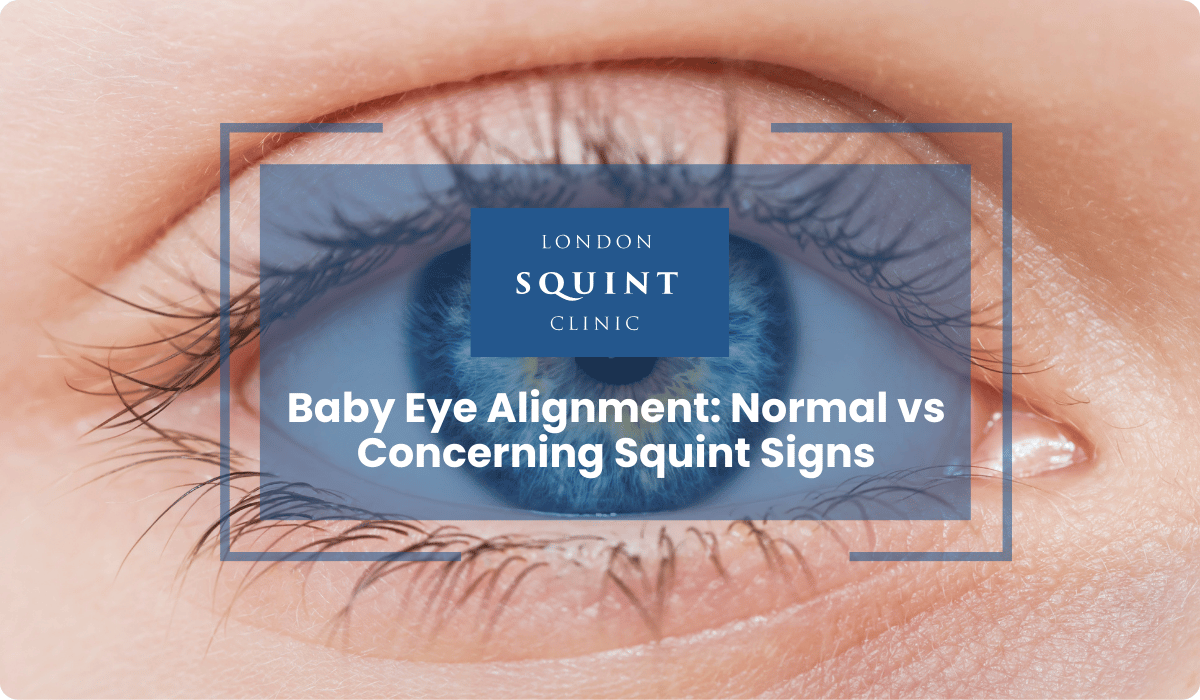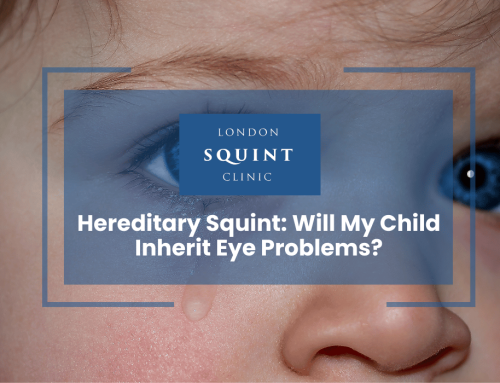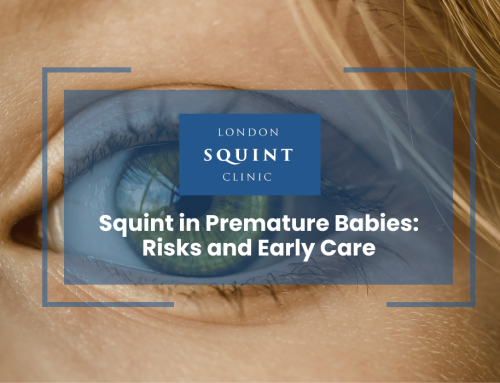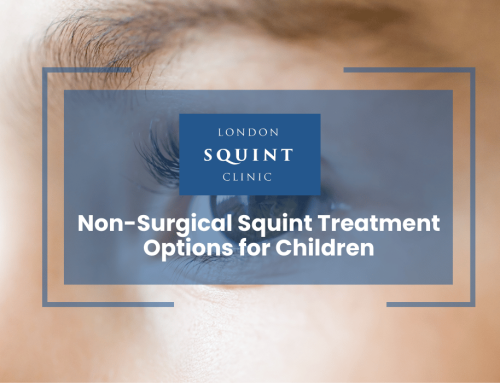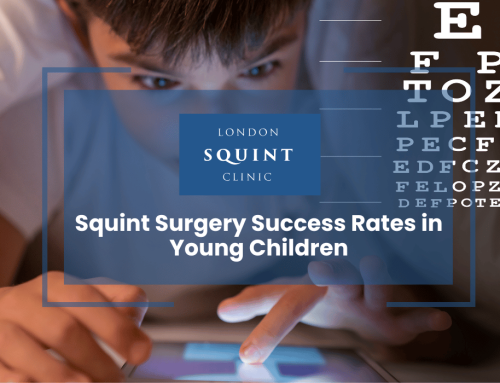Baby Eye Alignment: Normal vs Concerning Squint Signs
Essential Insights for Parents: Navigating Baby Eye Alignment
- Brief eye misalignment is normal in newborns up to 3-4 months as their visual system develops
- Persistent eye crossing or wandering beyond 4 months requires professional evaluation
- Pseudosquint (appearance of crossed eyes due to facial features) is common and resolves with growth
- True strabismus can be identified by asymmetrical light reflections in the eyes
- Early intervention for genuine eye misalignment is crucial for developing proper binocular vision
- Treatment options range from observation and glasses to patching therapy and surgery
- Regular pediatric vision screenings are important even without obvious symptoms
Table of Contents
- Understanding Normal Eye Development in Babies
- When Is a Baby’s Squint Normal and When Is It Concerning?
- How to Identify Pseudosquint vs True Strabismus in Infants
- Key Developmental Milestones for Baby Eye Alignment
- Warning Signs That Require Pediatric Ophthalmology Evaluation
- Testing and Diagnosis: What to Expect at Eye Appointments
- Treatment Options for Infant Squint and Eye Misalignment
Understanding Normal Eye Development in Babies
A newborn’s visual system undergoes remarkable development during the first year of life. At birth, babies have limited visual capabilities, with vision estimated at approximately 20/200 (meaning they can see at 20 feet what adults with normal vision can see at 200 feet). Their eye movements are often uncoordinated, and brief periods of eye misalignment are common in the first few months.
During the initial weeks, babies primarily respond to light, movement, and high-contrast patterns. By 2-3 months, infant eye coordination begins to improve as the brain develops connections between the eyes and visual cortex. This period marks the beginning of binocular vision development—the ability to use both eyes together to create a single, three-dimensional image.
The development of baby vision progresses rapidly between 3-5 months, when most infants begin to track moving objects more smoothly and develop better eye-hand coordination. By 5-8 months, depth perception improves significantly, and colour vision approaches adult levels. Throughout this period, occasional eye misalignment may occur as the complex neural pathways controlling eye movements continue to mature.
It’s important to understand that this developmental timeline varies among babies, with some achieving visual milestones earlier or later than others. However, persistent eye alignment issues beyond 3-4 months warrant professional evaluation to ensure proper visual development during this critical period.
When Is a Baby’s Squint Normal and When Is It Concerning?
Many parents observe newborn crossed eyes or misaligned gaze in their infants, prompting concerns about vision development. Understanding the difference between normal, transient eye alignment issues and concerning patterns is crucial for timely intervention.
In the first 2-3 months of life, brief episodes of eye misalignment are considered normal. Newborns haven’t yet developed the neural coordination required for consistent eye alignment. These temporary misalignments typically resolve as the visual system matures. Intermittent squint in babies, particularly when they’re tired or focusing intently, may not indicate a problem if it’s infrequent and resolves quickly.
However, certain patterns suggest a need for professional evaluation:
- Constant eye misalignment persisting beyond 3-4 months of age
- Frequent crossing or outward drifting of one eye
- Asymmetrical eye movements where one eye consistently deviates
- Eye misalignment that worsens over time rather than improving
- Family history of strabismus or early vision problems
The timing of eye alignment issues also provides important diagnostic clues. Infant squint that appears consistently after 4 months warrants prompt evaluation, as this period coincides with critical visual development stages. Similarly, eye misalignment that suddenly develops after previously normal alignment requires immediate assessment to rule out serious underlying conditions.
Remember that early intervention for true strabismus in babies leads to better outcomes, as treatment during the critical period of visual development (birth to approximately age 8) offers the best chance for developing normal binocular vision.
How to Identify Pseudosquint vs True Strabismus in Infants
One of the most common concerns for parents is distinguishing between pseudosquint in babies and true strabismus. Pseudosquint refers to the appearance of crossed eyes when no actual misalignment exists. This optical illusion often results from facial features rather than actual eye movement disorders.
The most common type of pseudosquint is epicanthal folds—extra skin folds at the inner corners of the eyes that are normal in many infants, particularly those of Asian descent. These folds can create the illusion that the eyes are turning inward (esotropia) when they are actually properly aligned. A wide nasal bridge or flat facial profile can also contribute to this appearance.
In contrast, true strabismus involves actual misalignment of the eyes. The key difference is that in true strabismus, the light reflection (corneal light reflex) appears in different positions when a light is shined toward both eyes simultaneously. In pseudosquint, these light reflections appear symmetrically positioned in both eyes.
Parents can perform a simple observation at home: take photos of your baby looking directly at a light source or camera flash (at a safe distance). In these photos, the light reflection should appear in the same position in both eyes. Asymmetrical reflections may indicate true eye misalignment. However, professional assessment remains essential for accurate diagnosis.
Another distinguishing feature is consistency—pseudosquint appears the same regardless of which direction the baby looks, while true strabismus often becomes more or less noticeable with different gaze directions. Pseudosquint typically resolves naturally as the child’s face grows and facial features develop, requiring no treatment, whereas true strabismus requires medical intervention.
Key Developmental Milestones for Baby Eye Alignment
Understanding the timeline of normal eye alignment development helps parents recognise when their baby is progressing appropriately and when to seek professional advice. These milestones serve as general guidelines, recognising that individual development varies.
Birth to 1 month: Newborns may exhibit brief periods of eye misalignment as their visual system begins developing. Limited eye tracking abilities and occasional crossed eyes are normal during this period. Babies can typically see objects 8-12 inches from their face—approximately the distance to a parent’s face during feeding.
2-3 months: By this age, most infants begin developing more consistent eye alignment. They should start tracking moving objects horizontally and show interest in high-contrast patterns. Brief misalignments may still occur but should become less frequent. Babies typically begin making eye contact more reliably during this period.
4-5 months: Eye coordination improves significantly. Babies should demonstrate more stable eye alignment with only occasional misalignment. Eye tracking becomes smoother, and infants begin developing depth perception. They typically show increased visual interest in their surroundings and can focus on smaller objects.
6-8 months: By this stage, eye alignment should be consistently stable in most infants. Babies develop more sophisticated eye-hand coordination and can track moving objects in all directions. Depth perception continues improving, supporting crawling and exploration.
9-12 months: Eye alignment should be stable and consistent. Babies demonstrate good visual tracking, recognition of familiar objects at a distance, and improved depth perception supporting their increasing mobility. Visual acuity continues developing toward adult levels.
If your baby’s eye alignment doesn’t follow this general progression—particularly if misalignment persists or worsens after 4 months—consultation with a pediatric ophthalmologist is recommended for proper assessment of infant eye coordination development.
Warning Signs That Require Pediatric Ophthalmology Evaluation
While some degree of eye misalignment can be normal in young infants, certain warning signs indicate the need for prompt professional evaluation. Being vigilant about these indicators can lead to earlier intervention for congenital eye misalignment and better visual outcomes.
Persistent misalignment: Any eye turning inward or outward that persists consistently beyond 3-4 months of age requires evaluation. Constant misalignment, rather than occasional episodes, is particularly concerning.
Asymmetrical eye movements: If one eye consistently deviates while the other maintains proper alignment, this asymmetry warrants assessment. This pattern may indicate a specific type of strabismus affecting one eye more than the other.
Abnormal head positioning: Babies who consistently tilt or turn their head to one side when focusing may be compensating for eye misalignment or vision problems. This adaptation helps them align their eyes or use their better-seeing eye.
Excessive tearing or eye redness: While not directly related to alignment, these symptoms may indicate other eye conditions that can affect visual development and should be evaluated.
Light sensitivity: Unusual sensitivity to light (photophobia) in infants may signal various eye conditions requiring assessment.
Poor visual tracking: By 3-4 months, babies should follow moving objects with both eyes. Difficulty with eye tracking in infants may indicate alignment or vision problems.
White pupil reflection: Instead of the normal red-eye effect in photographs, a white reflection in one or both pupils requires immediate medical attention as it may indicate serious conditions like congenital cataracts or retinoblastoma.
Family history: Babies with family members who had childhood strabismus, amblyopia (lazy eye), or required early glasses have higher risk for similar conditions and benefit from earlier screening.
If you observe any of these warning signs, consult your GP for referral to a pediatric ophthalmologist who specialises in infant vision assessment and treatment.
Testing and Diagnosis: What to Expect at Eye Appointments
When your baby requires evaluation for possible eye alignment issues, understanding the pediatric ophthalmology assessment process helps prepare both parent and child for a productive examination. These specialised evaluations are designed to be child-friendly while gathering crucial diagnostic information.
Initial assessment: The appointment typically begins with a detailed history, including pregnancy and birth information, developmental milestones, family history of eye conditions, and specific concerns about your baby’s eye alignment. The specialist will observe your baby’s visual behaviour, including how they focus on faces and objects.
Visual acuity testing: For infants, visual acuity is assessed through preferential looking tests using cards with contrasting patterns or pictures. The specialist observes which patterns attract the baby’s attention, providing information about visual development.
Alignment evaluation: Several techniques assess eye alignment in infants:
- Hirschberg test: A light is shined at the baby’s eyes to observe the reflection position on each cornea
- Cover test: One eye is briefly covered to observe how the uncovered eye moves, then the process is repeated for the other eye
- Prism tests: Special prisms may be used to measure the degree of misalignment precisely
Pupillary responses: The specialist will check how your baby’s pupils respond to light, providing information about the visual pathways.
Eye movement assessment: The doctor will observe how your baby tracks moving objects in different directions to evaluate eye muscle function and coordination.
Cycloplegic examination: Special eye drops may be used to temporarily dilate the pupils and relax the focusing muscles. This allows for a comprehensive examination of the eye’s internal structures and accurate assessment of any refractive errors (need for glasses).
Additional testing: Depending on findings, further specialised tests may be recommended to evaluate specific aspects of visual function or eye health.
These examinations are generally quick and non-invasive, though the dilating drops may cause temporary light sensitivity and blurred vision. The comprehensive assessment provides the information needed to determine whether your baby has normal eye development, pseudosquint, or true strabismus requiring intervention.
Treatment Options for Infant Squint and Eye Misalignment
When a baby is diagnosed with true strabismus or significant eye misalignment, early intervention is crucial for optimal visual development. Treatment approaches vary based on the specific type of misalignment, its severity, underlying causes, and the child’s age. A comprehensive treatment plan may include several approaches:
Observation: For mild or intermittent misalignment in very young infants, careful monitoring may be recommended initially, as some alignment issues resolve naturally with neurodevelopmental maturation. Regular follow-up appointments track progress and ensure timely intervention if improvement doesn’t occur.
Glasses: Many infants with accommodative esotropia (inward-turning eyes related to focusing efforts) benefit significantly from prescription glasses. Even very young babies can adapt well to wearing glasses with appropriate frames designed for infants. Correcting underlying refractive errors often improves alignment by reducing the focusing effort that triggers the misalignment.
Patching therapy: If the misalignment has led to amblyopia (reduced vision in one eye), patching the stronger eye for prescribed periods encourages visual development in the weaker eye. The patching schedule varies based on the child’s age and the severity of amblyopia.
Eye exercises: For certain types of misalignment, orthoptic exercises may be prescribed to strengthen eye muscle coordination. These are typically more applicable for older children who can follow instructions.
Prism therapy: Special prisms incorporated into glasses can help align images for both eyes, potentially improving binocular vision and alignment in some cases.
Botulinum toxin (Botox) injections: In specific situations, Botox injections into eye muscles can temporarily weaken overactive muscles, potentially improving alignment. This approach may be used diagnostically or therapeutically.
Surgery: When significant misalignment persists despite conservative measures, surgical correction may be recommended. Surgery involves adjusting the position of the eye muscles to improve alignment. The timing of surgery depends on the type and severity of strabismus, with some conditions benefiting from early intervention to promote binocular vision development.
The treatment journey often involves combinations of these approaches, with regular monitoring and adjustments as the child grows. The goal is not merely cosmetic improvement but the development of proper binocular vision—the ability to use both eyes together effectively—which supports depth perception and visual processing throughout life.
Frequently Asked Questions
At what age should I worry about my baby’s crossed eyes?
You should seek evaluation if your baby’s eyes remain consistently crossed beyond 3-4 months of age. While brief eye misalignment is normal in newborns up to 2-3 months as their visual system develops, persistent crossing after 4 months warrants professional assessment. Constant misalignment, rather than occasional episodes, is particularly concerning and requires prompt evaluation by a pediatric ophthalmologist.
What is the difference between pseudosquint and true strabismus?
Pseudosquint is an illusion of crossed eyes caused by facial features (like epicanthal folds or a wide nasal bridge) with no actual eye misalignment. True strabismus involves genuine misalignment where the eyes point in different directions. The key difference is that in pseudosquint, light reflections appear symmetrically in both eyes, while in true strabismus, these reflections appear in different positions when light is shined toward both eyes simultaneously.
Can a baby’s squint correct itself without treatment?
Some types of infant eye misalignment can resolve naturally without intervention, particularly the intermittent misalignment common in the first 2-3 months of life. Pseudosquint also resolves as facial features develop. However, true strabismus that persists beyond 4 months typically requires medical intervention and rarely corrects itself. Early evaluation is essential to distinguish between conditions that will self-resolve and those requiring treatment.
How is strabismus in babies diagnosed?
Strabismus in babies is diagnosed through specialized pediatric ophthalmology assessments including: the Hirschberg test (observing light reflections on the corneas), cover tests (covering each eye alternately to observe movement), pupillary response evaluation, and eye movement tracking. The doctor may also use cycloplegic eye drops to dilate pupils for a comprehensive internal eye examination and to assess for refractive errors that might contribute to misalignment.
What causes eye misalignment in infants?
Eye misalignment in infants can result from multiple factors including: refractive errors (significant farsightedness), muscle control issues, cranial nerve abnormalities affecting eye muscles, family history of strabismus, premature birth, and certain neurological conditions. In many cases, the misalignment occurs as the visual system develops coordination. Less commonly, misalignment may result from serious conditions like congenital cataracts or retinal problems that require immediate attention.
Will my baby need surgery for crossed eyes?
Not all babies with crossed eyes require surgery. Treatment depends on the specific diagnosis, severity, and response to conservative measures. Many infants with accommodative strabismus improve significantly with glasses alone. Others may benefit from patching therapy or exercises. Surgery is typically considered when significant misalignment persists despite these approaches, or for certain types of strabismus that don’t respond well to non-surgical treatments. The decision is individualized based on comprehensive ophthalmological assessment.
How do glasses help with infant strabismus?
Glasses help with infant strabismus by correcting underlying refractive errors (particularly farsightedness) that cause the eyes to work harder for focusing, which can trigger inward turning. By providing the correct prescription, glasses reduce the focusing effort needed, allowing the eyes to maintain better alignment. For accommodative esotropia, glasses can dramatically improve alignment even in very young babies. Special frames designed for infants ensure proper fit and comfort.
Find out if you are suitable for Double Vision Treatment
Not everyone is eligible for double vision surgery.
Find out if you could benefit from this life-changing surgery by taking the quick self-suitability quiz below:
Our most popular procedures

Hello, I’m Nadeem Ali
I’m one of the few eye surgeons in the world with 100% focus on Squint and Double Vision Surgery.
I have 24 years of eye surgery experience, and worked for 13 years as a Consultant at London’s renowned Moorfields Eye Hospital.
In 2023, I left the NHS to focus fully on treating patients from across the world at the London Squint Clinic. You can read more about me here.
There’s lots of information on the website about: squint surgery, double vision surgery and our pricing.
The most rewarding part of my job is hearing patients tell me how squint or double vision surgery has changed their lives. You can hear these stories here.
Mr Nadeem Ali
MA MB BChir MRCOphth FRCSEd(Ophth)
